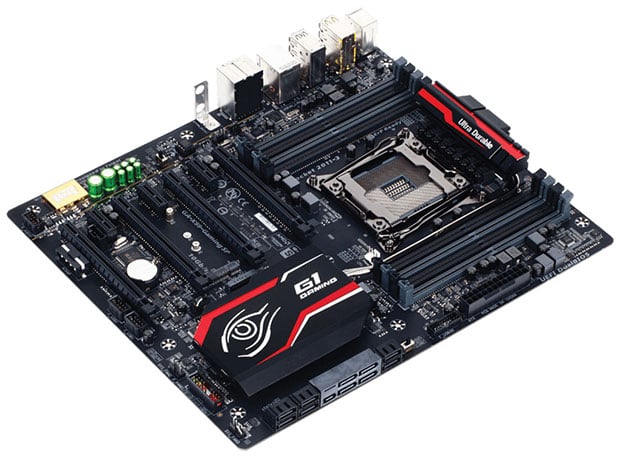Gigabyte X99-SOC Champion & X99 Gaming 5P Haswell E Motherboards Reviewed
Like the SOC Champion, the X99 Gaming 5P has four PCIe x16 slots (two x16, two x8), with x1 slots tucked between. The X99 Gaming 5P also has a couple of M.2 slots, however, they are of the 10GB/s variety. And one of the slots is meant to be used with an optional 802.11ac WiFi module.
Overall, the layout is good, but there are a handful of connectors tucked between slots (like the M.2 ports and auxiliary audio input) and a supplementary power connector that’s mounted horizontal to the PCB, while all others are perpendicular, but these are minor niggles.
The board also offers a total of 16 USB ports (eight USB 3.0 and eight USB 2.0), ten SATA 6Gbps connectors, and a SATA Express port. As we’ve mentioned, the board supports CrossFire and SLI, Gigabyte’s DualBIOS technology, and On/Off USB Charge support via its yellow ports. The X99 Gaming 5P also sports gold plated audio outputs and a Killer E2200-series LAN controller too.
Gigabyte also put considerable resources into optimizing the audio-related features on this board. The X99 Gaming 5P features Creative Labs’ Sound Core3D chip, with full support for the Sound Blaster SBX Pro Studio suite. The audio circuitry on the board gets its own zone, that’s isolated from other componentry, it uses high end, Nichicon audio capacitors too.
Other noteworthy features newly designed lighted heatsinks and a redesigned BIOS / UEFI that gives users the ability to navigate through its various menus with a mouse or keyboard and can be configured for a variety of different views.
The X99 Gaming 5P is also packing a ton of external IO connectivity. There are a total of 10 USB ports in the backplane, along with PS/2 mouse and keyboard powers, an RJ45 network jack, audio ports, and a mounting bracket for wireless antennas, should you choose to install an optional, internal M.2 802.11ac WiFi controller.










